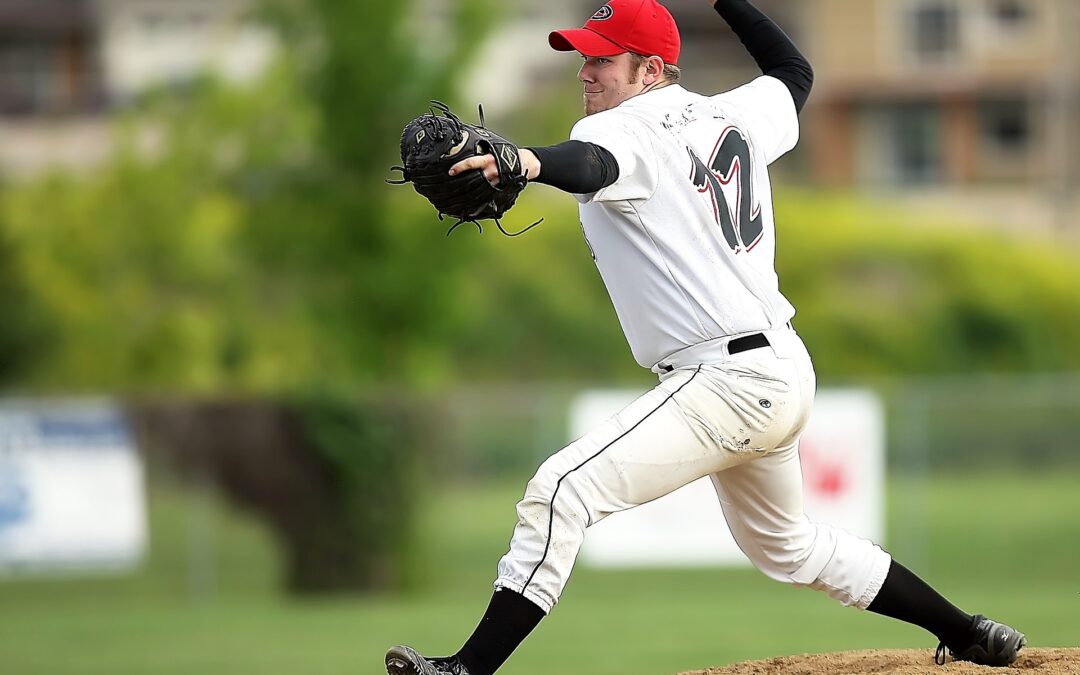Initial Kinematic Chain Injuries Increase Hazard of Subsequent Arm Injuries in Professional Baseball Pitchers
Bullock GS, Thigpen CA, Noonan TK, Kissenberth MJ, Shanley E. J Shoulder Elbow Surg. 2022 May 19. doi: 10.1016/j.jse.2022.04.016
https://pubmed.ncbi.nlm.nih.gov/35598837/
Take-Home Message
Arm injuries occurred at a greater rate by the end of the season for minor league baseball pitchers who sustained a previous kinematic chain injury (in the lower extremity), likely due to the cumulative pitching load over the season and subsequent fatigue. Sports medicine clinicians should monitor pitching mechanics and compensations after lower extremity injuries.
Background
Baseball pitchers sustain a high number of time-loss arm injuries than position players and often struggle to return to play. Deficits in balance and range of motion in the lower extremities increase the risk for arm injuries, given that the pitching motion begins in the lower extremity. However, there is limited information on how lower extremity injuries relate to arm injuries.
Study Goal
The authors prospectively investigated whether an initial trunk or lower extremity injury related to a subsequent arm injury (shoulder or elbow) in minor league baseball pitchers. They performed a secondary analysis to assess the association between an initial arm injury on a subsequent arm injury.
Methods
The authors assessed data from minor league teams between 2013-2019. Authors defined an injury as one that led to missing at least one practice or competition and that required medical care from an athletic trainer or physician. They defined an athlete exposure as one athlete participating in one practice or competition. The authors then determined if an initial trunk or lower extremity injury or initial arm injury related to a subsequent arm injury after returning to play.
Results
Pitchers with an initial trunk or lower extremity injury were ~2.6 times more likely than uninjured peers to experience a subsequent arm injury at any given moment after returning to play. Additionally, those with an initial shoulder injury had a greater chance of a subsequent arm injury than those with an initial elbow injury.
Viewpoints
Pitching mechanics or the force generation of the lower extremity may be altered after an initial kinematic chain injury (trunk or lower extremity). These compensations may affect subsequent injury risk. The authors proposed that tissues may suffer from decreased resiliency after the initial injury or that there are changes in strength or range of motion. This issue is compounded as pitching load and fatigue accumulate throughout the season, leading to a subsequent arm injury. However, these proposed mechanisms require further research to explore if an initial kinematic chain injury indeed causes these subsequent arm injuries or if they simply help identify someone at greater risk for injury. Clinicians should assess compensations in pitching mechanics when determining athlete readiness, especially while pitching in fatigued states to understand the full extent of a player’s readiness to return to sport.
Clinical Implications
Sports medicine clinicians should assess for changes in pitching mechanics in their return-to-play decisions after a lower extremity or shoulder injury.
Questions for Discussion
If you have done so, how have you managed a pitcher’s return to throw after a lower extremity injury? How would you evaluate a pitcher’s readiness after an initial injury?
Related Posts
- Hidden in Plain Sight: Improving Quantification of Baseball Pitcher Workload
- The Impact of Pitch Counts and Days of Rest on Performance among Major-League Baseball Pitchers
- Throwing It Out There Again: Highly Specialized Baseball Athletes Report More Upper Extremity Overuse Injuries
Written by Jennifer Xu
Reviewed by Jeffrey Driban and Stephen Thomas



I have worked with a pitcher who have pulled his hamstring by running sprints with the team. He was pretty mobile after it and was only shut down for about a week and a half before he started to do some pitching again. He had to be making progress with rehab before he was able to start the running progression. It took him about a month and a half before returning to the mound where he pulled it yet again. He had to repeat everything he just did for the past month and a half over again. We evaluated his readiness by starting the running progression and throw without any pain. He was completely pain free with both of those things and we decided he was ready to return. We also made sure that he was mentally ready to return after he re-tearing it.
I really enjoyed this article based in the topic. I think this is a topic that isn’t talked about a lot because it uses the word pitchers. As soon as someone says this we automatically think injury to the arm. This article takes me back to one of my therapeutic classes when talking about kinetic chain. The body works in a kinetic chain in complex movements moving energy/force from one link to the next. This goes for pitchers at well when throwing a ball. Having an injury to the lower extremity will affect the biomechanics which may put more stress on the arm because everything is not moving in sync. It would be beneficial for clinicians to strengthen the lower extremity as well as the upper to prevent injuries from happening.